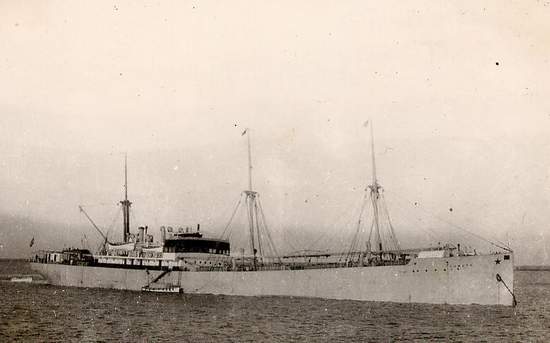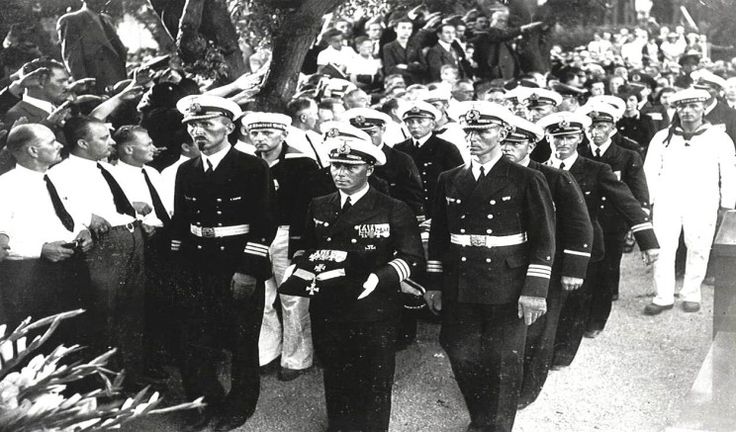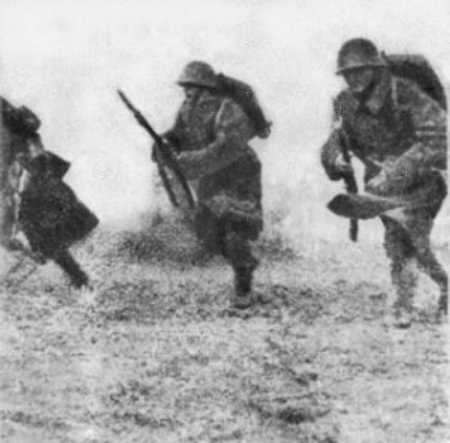Battle of the Atlantic: U-38 (Kapitänleutnant Heinrich Liebe) is 65 miles northwest of Noup Head, Orkneys on 26 March 1940 when its crew spots 3,794-ton Norwegian freighter Cometa. The Cometa is running with its lights on at night, generally signifying a neutral ship. Liebe stops the ship (apparently it stopped on its own after realizing the U-38 was there) and is told that HMS Kingston Peridot, a British trawler, had instructed it to go to Kirkwall, Scotland for the examination of its cargo. To that end, there is a Royal Navy officer and four ratings on board, which technically makes it a warship. Liebe instructs the crew to abandon ship, then sinks it at 02:20 with one torpedo, the ship breaking in two amidships. The forepart remains afloat, so Liebe sends it down with another torpedo. All 42 crew survive and are soon picked up a trawler, HMS Northern Sky.
U-21 (Wolf-Harro Stiebler) runs aground at Oldknuppen Island, Norway after a navigational error. The Norwegians intern the boat and tow it to Mandal, Norway, thence Kristiansand.
The Mauretania makes it to the Panama Canal without incident. She is on her way to Australia to be refitted.
Convoy OA 117 departs from Southend.
Western Front: The BEF takes on a little more responsibility as the 51st Highland Division sets up in the Saar region. They replace French soldiers in the line, which is a first.
Royal Navy: First Lord of the Admiralty Winston Churchill has a flash of inspiration: "Memo: More backgammon sets on warships - quicker game than cards."
US Army Air Corps: The Curtiss C-46 Commando has its first flight. The new cargo plane has a "double bubble" design with two pressurized cabins. While the airlines are not interested in the plane, USAAC Chief of Staff General Henry “Hap” Arnold likes its potential as a cargo plane and places an initial order of 200.
Soviet Government: The Kremlin recalls its ambassador to France after French complaints about him. Soviet Ambassador to Paris Jakob Suritz sent Stalin a message congratulating for him his victory over "Anglo-French warmongers."
Soviet/German Relations: Hitler enjoys personal diplomacy - he will travel far and wide to meet a fellow dictator - and asks Stalin to meet to discuss their mutual border. The two have never met - Hitler has even met the British and French leaders - but Stalin declines to meet anyway.
Italian/Hungarian Relations: Count Pál János Ede Teleki, Prime Minister of Hungary, visits with Mussolini in Rome. Mussolini tells Teleki and Ciano, who attends the meeting, that Italy will join the Germans in the war at some point.
Canada: In the general elections, the Liberals under William Lyon Mackenzie King win 178 seats, the Conservatives take 39, and all other parties win 28.
New Zealand: The Labour Prime Minister, Michael Savage, passes away at age 68.
French Homefront: Prime Minister Reynaud broadcasts a speech to the public urging the nation to carry on a "total war" against the Germans. This is an old phrase from World War I.
British Homefront: Morale is high as the long Easter Weekend ends, with long queues at the train stations and an impromptu sing-a-long at Waterloo Station.
Wilhelm Solf, an Austrian undergraduate at Oxford University, is interned after he photographs a crashed RAF plane. As reported in the London Times, many citizens feel that the government is treating Germans caught in the country by the war harshly. This is buttressed by a newsreel being shown in cinemas which details the recent incident of an RAF bomber accidentally landing in Germany, the crew meeting with local farmers there on good terms, and then taking off again before being caught.
China: The Japanese, reinforced in recent days, recapture Wuyuan from the Chinese 8th War Area. The Chinese fall back to the banks of Fan-chi-chu and launch attacks at Xin'an, Xishanzui, Xixiaozhao, and Manko.
American Homefront: General Motors officially cancels the LaSalle nameplate in the Cadillac division. While LaSalles have sold reasonably well (often better than Cadillacs), the thinking apparently is that the company should focus on the more prestigious Cadillac brand. Production of LaSalles ceases in August. Final LaSalle designs are incorporated into new Cadillac models.
Future History: James Caan is born in the Bronx, New York. He becomes famous as a movie star in the '60s and '70s, most famously for his role in "The Godfather."
Nancy Pelosi is born in Baltimore, Maryland. She becomes the 52nd Speaker of the U.S. House of Representatives.
Many Curtiss C-46 Commando cargo planes became of tremendous use in the Burma theater of operations, where they supplied the Chinese over the "Hump" of the Himalayas. Many remain in service to this day, in the 21st Century. While never fully given its due in terms of public perceptions, the decidedly un-flashy C-46 is one of the most useful, dependable and enduring aircraft in aviation history.
March 2, 1940: Soviets Swarm West in Finland
March 3, 1940: Soviets Across Gulf of Viipuri
March 4, 1940: USSR Apologizes to Sweden
March 5, 1940: Katyn Forest Massacre Approved
March 6, 1940: Finns Head to Moscow
March 7, 1940: The Coal Ships Affair
March 8, 1940: Peace Talks Begin in Moscow
March 9, 1940: Soviets Harden Peace Terms
March 10, 1940: Germany Draws Closer to Italy
March 11, 1940: Winter War Peace Terms Finalized
March 12, 1940: War is Over (If You Want It)
March 13, 1940: Winter War Ends
March 14, 1940: Evacuating Karelia
March 15, 1940: The Bletchley Bombe
March 16, 1940: First British Civilian Killed
March 17, 1940: Enter Dr. Todt
March 18, 1940: Mussolini To Join the War
March 19, 1940: Daladier Resigns
March 20, 1940: Soviets Occupy Hango Naval Base
March 21, 1940: Paul Reynaud Leads France
March 22, 1940: Night Fighters Arise!
March 24, 1940: French Consider Alternatives
March 25, 1940: Reynaud Proposes Action
March 26, 1940: C-46 First Flight
March 27, 1940: Himmler Authorizes Auschwitz Construction
March 28, 1940: Allies Ponder Invading Norway
March 29, 1940: Soviets Prefer Neutrality
March 30, 1940: Allied Uncertainty
March 31, 1940: The Tiger Cage
2021
U-21 (Wolf-Harro Stiebler) runs aground at Oldknuppen Island, Norway after a navigational error. The Norwegians intern the boat and tow it to Mandal, Norway, thence Kristiansand.
The Mauretania makes it to the Panama Canal without incident. She is on her way to Australia to be refitted.
Convoy OA 117 departs from Southend.
Western Front: The BEF takes on a little more responsibility as the 51st Highland Division sets up in the Saar region. They replace French soldiers in the line, which is a first.
Royal Navy: First Lord of the Admiralty Winston Churchill has a flash of inspiration: "Memo: More backgammon sets on warships - quicker game than cards."
US Army Air Corps: The Curtiss C-46 Commando has its first flight. The new cargo plane has a "double bubble" design with two pressurized cabins. While the airlines are not interested in the plane, USAAC Chief of Staff General Henry “Hap” Arnold likes its potential as a cargo plane and places an initial order of 200.
Soviet Government: The Kremlin recalls its ambassador to France after French complaints about him. Soviet Ambassador to Paris Jakob Suritz sent Stalin a message congratulating for him his victory over "Anglo-French warmongers."
Soviet/German Relations: Hitler enjoys personal diplomacy - he will travel far and wide to meet a fellow dictator - and asks Stalin to meet to discuss their mutual border. The two have never met - Hitler has even met the British and French leaders - but Stalin declines to meet anyway.
Italian/Hungarian Relations: Count Pál János Ede Teleki, Prime Minister of Hungary, visits with Mussolini in Rome. Mussolini tells Teleki and Ciano, who attends the meeting, that Italy will join the Germans in the war at some point.
Canada: In the general elections, the Liberals under William Lyon Mackenzie King win 178 seats, the Conservatives take 39, and all other parties win 28.
New Zealand: The Labour Prime Minister, Michael Savage, passes away at age 68.
French Homefront: Prime Minister Reynaud broadcasts a speech to the public urging the nation to carry on a "total war" against the Germans. This is an old phrase from World War I.
British Homefront: Morale is high as the long Easter Weekend ends, with long queues at the train stations and an impromptu sing-a-long at Waterloo Station.
Wilhelm Solf, an Austrian undergraduate at Oxford University, is interned after he photographs a crashed RAF plane. As reported in the London Times, many citizens feel that the government is treating Germans caught in the country by the war harshly. This is buttressed by a newsreel being shown in cinemas which details the recent incident of an RAF bomber accidentally landing in Germany, the crew meeting with local farmers there on good terms, and then taking off again before being caught.
China: The Japanese, reinforced in recent days, recapture Wuyuan from the Chinese 8th War Area. The Chinese fall back to the banks of Fan-chi-chu and launch attacks at Xin'an, Xishanzui, Xixiaozhao, and Manko.
American Homefront: General Motors officially cancels the LaSalle nameplate in the Cadillac division. While LaSalles have sold reasonably well (often better than Cadillacs), the thinking apparently is that the company should focus on the more prestigious Cadillac brand. Production of LaSalles ceases in August. Final LaSalle designs are incorporated into new Cadillac models.
Future History: James Caan is born in the Bronx, New York. He becomes famous as a movie star in the '60s and '70s, most famously for his role in "The Godfather."
Nancy Pelosi is born in Baltimore, Maryland. She becomes the 52nd Speaker of the U.S. House of Representatives.
Many Curtiss C-46 Commando cargo planes became of tremendous use in the Burma theater of operations, where they supplied the Chinese over the "Hump" of the Himalayas. Many remain in service to this day, in the 21st Century. While never fully given its due in terms of public perceptions, the decidedly un-flashy C-46 is one of the most useful, dependable and enduring aircraft in aviation history.
 |
| The Cometa, sunk on 26 March 1940. Photo Courtesy of Library of Contemporary History, Stuttgart. |
March 1940
March 1, 1940: Soviet Breakthroughs Past ViipuriMarch 2, 1940: Soviets Swarm West in Finland
March 3, 1940: Soviets Across Gulf of Viipuri
March 4, 1940: USSR Apologizes to Sweden
March 5, 1940: Katyn Forest Massacre Approved
March 6, 1940: Finns Head to Moscow
March 7, 1940: The Coal Ships Affair
March 8, 1940: Peace Talks Begin in Moscow
March 9, 1940: Soviets Harden Peace Terms
March 10, 1940: Germany Draws Closer to Italy
March 11, 1940: Winter War Peace Terms Finalized
March 12, 1940: War is Over (If You Want It)
March 13, 1940: Winter War Ends
March 14, 1940: Evacuating Karelia
March 15, 1940: The Bletchley Bombe
March 16, 1940: First British Civilian Killed
March 17, 1940: Enter Dr. Todt
March 18, 1940: Mussolini To Join the War
March 19, 1940: Daladier Resigns
March 20, 1940: Soviets Occupy Hango Naval Base
March 21, 1940: Paul Reynaud Leads France
March 22, 1940: Night Fighters Arise!
March 24, 1940: French Consider Alternatives
March 25, 1940: Reynaud Proposes Action
March 26, 1940: C-46 First Flight
March 27, 1940: Himmler Authorizes Auschwitz Construction
March 28, 1940: Allies Ponder Invading Norway
March 29, 1940: Soviets Prefer Neutrality
March 30, 1940: Allied Uncertainty
March 31, 1940: The Tiger Cage
2021










